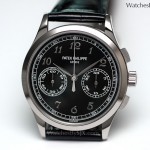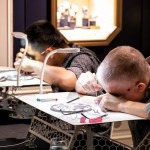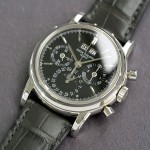The Wonderfully Artistic in Christie’s Hong Kong
From VC "Les Masques" to an extraordinarily cloisonné dial by Nelly Richard.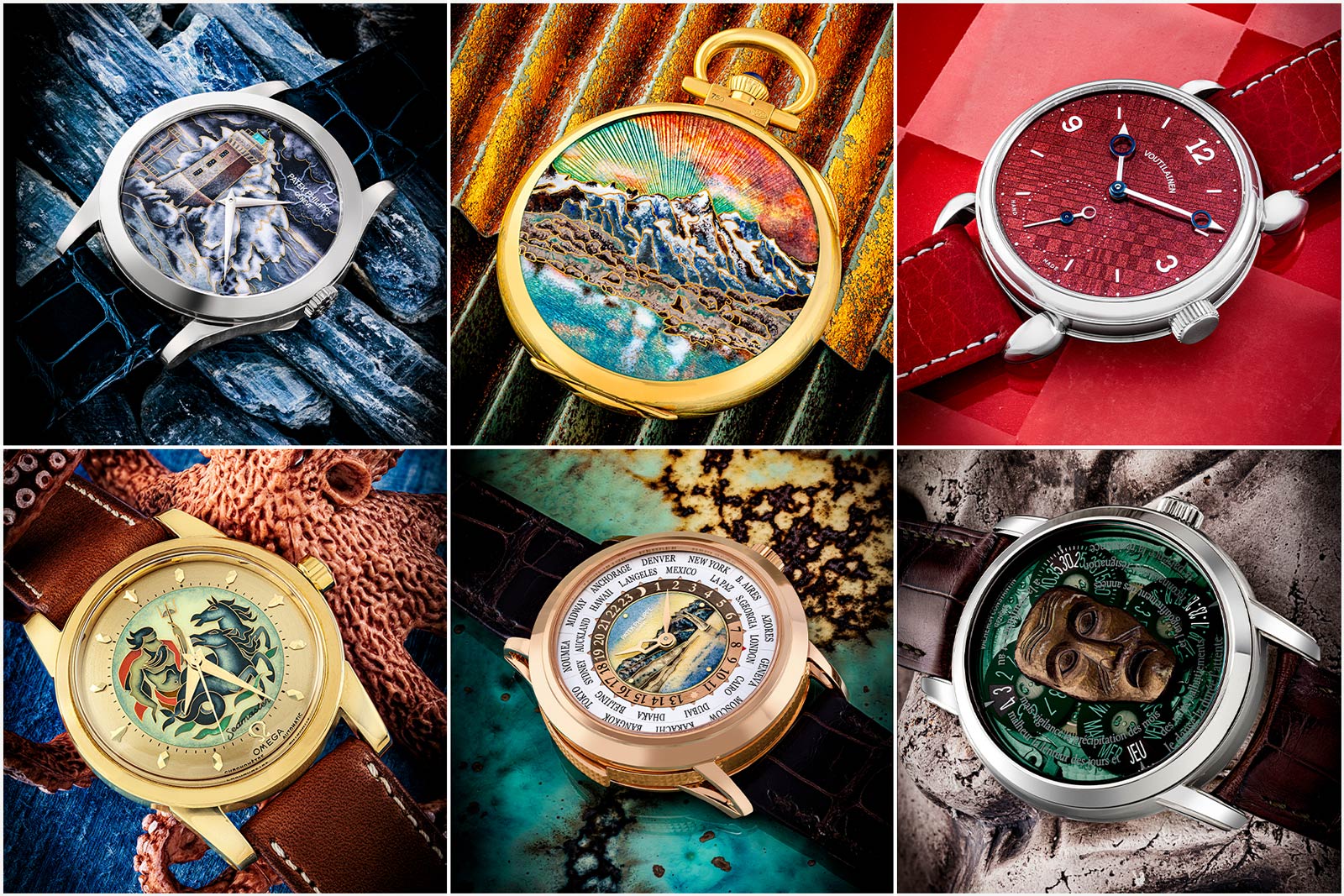
Having explored the best of independent watchmaking, we now pivot to the artisanal masterpieces at Christie’s Hong Kong sale on November 26, ranging from a 1950s cloisonné Omega by Nelly Richard to a Patek Philippe Dome Clock.
Amongst the more esoteric is the Vacheron Constantin Métiers d’Art “Les Masques”, the quartet of timepieces each featuring a miniature sculpture replicating tribal masks in Geneva’s Barbier-Mueller Museum.
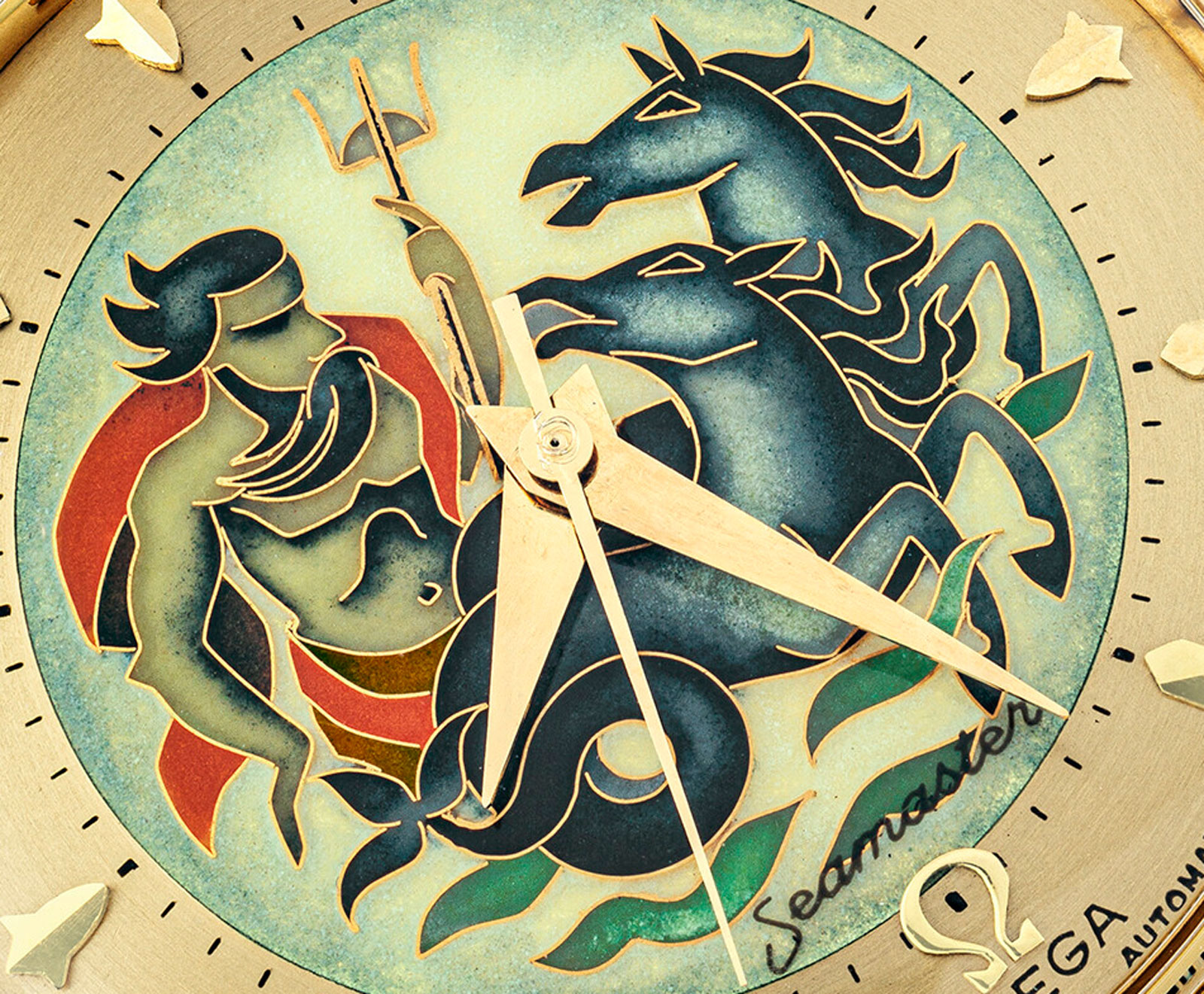
The auction on November 26 is made up of two parts, starting with Important Watches (lots 2201-2343) at 1 pm – the catalogue is available here.
It will be followed by the OAK Collection (lots 2501-2639) at 6:30 pm – see the full catalogue here.
Lots 2224-2227: Vacheron Constantin Métiers d’Art “Les Masques” set
One of Vacheron Constantin’s most distinctive Metiers d’Art creations, “Les Masques” is a literal description of the watches – each contains a miniature sculpture that deftly reproduces tribal masks from around the world that are part of the primitive art collection in the renowned Barbier-Mueller Museum.
Each of the three years from 2007 to 2009 saw the launch of a “Les Masques” set made up of four watches, with each watch representing one of the four continents of Asia, Oceania, Africa, and the Americas. This present set is from 2009 and depicts masks from Gabon, Mexico, Indonesia, and China.
The masks were micro-sculptures of 18k gold that were intricately engraved and coloured by hand, and then installed on a tinted sapphire dial bearing verses by the late French poet Michel Butor printed in gilt.
With the mask taking centerstage, the indications are relegated to the edges of the dial, with windows revealing the hours, minutes, day, and date discreetly positioned in each of the dial’s quadrants.
All watches of the Les Masques series are housed in the 40 mm case with the cal. 2460 automatic movement, like the other Metiers d’Art creations of Vacheron Constantin.
Each of the four watches is offered individually. All are unworn and include their respective certificate. Each has the same estimate of HK$400,000-800,000, or about US$51,200-102,500.
The Mask of Mexico is inspired by a pendant basalt mask originating from the Mezcala civilisation that was found in the Mexican state of Guerrero and dates from 300-100 BC. It is housed in a platinum case. Full lot details here.
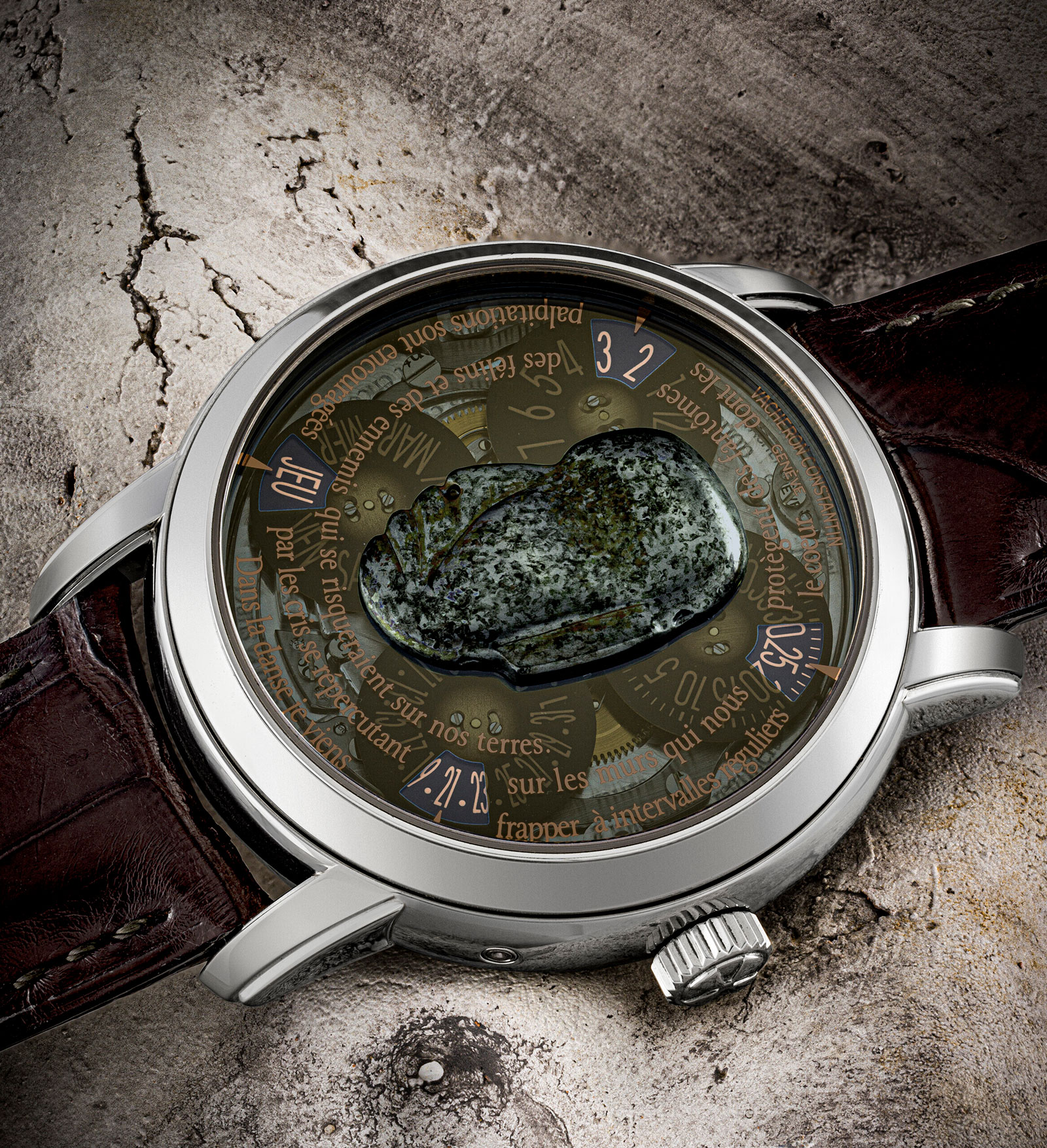
The Mask of Gabon is based on a white kaolin ngontang mask crafted by the Fang people. The mask is employed in ancestral worship, serving as a means to honour their deceased spirits. It is housed in an 18k pink gold case. For more, view the catalogue entry here.
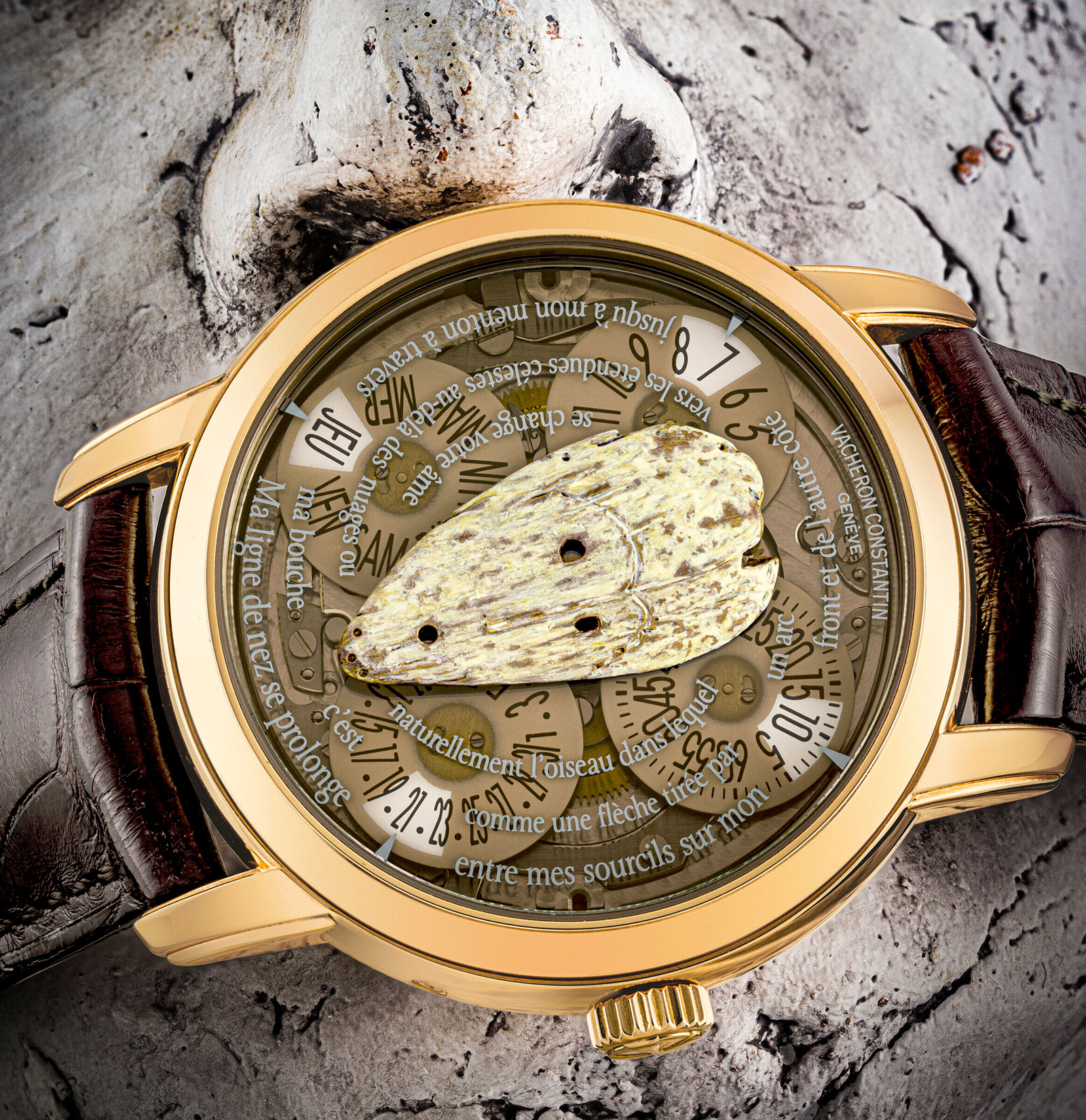
The Mask of Indonesia depicts a wayang mask created by the Sasak people, situated on the Indonesian island of Lombok. Typically worn by the character of an elderly man, the mask is a prominent element in the Balinese wayang topeng performances. It is housed in 18k white gold. For more, view the catalogue here.
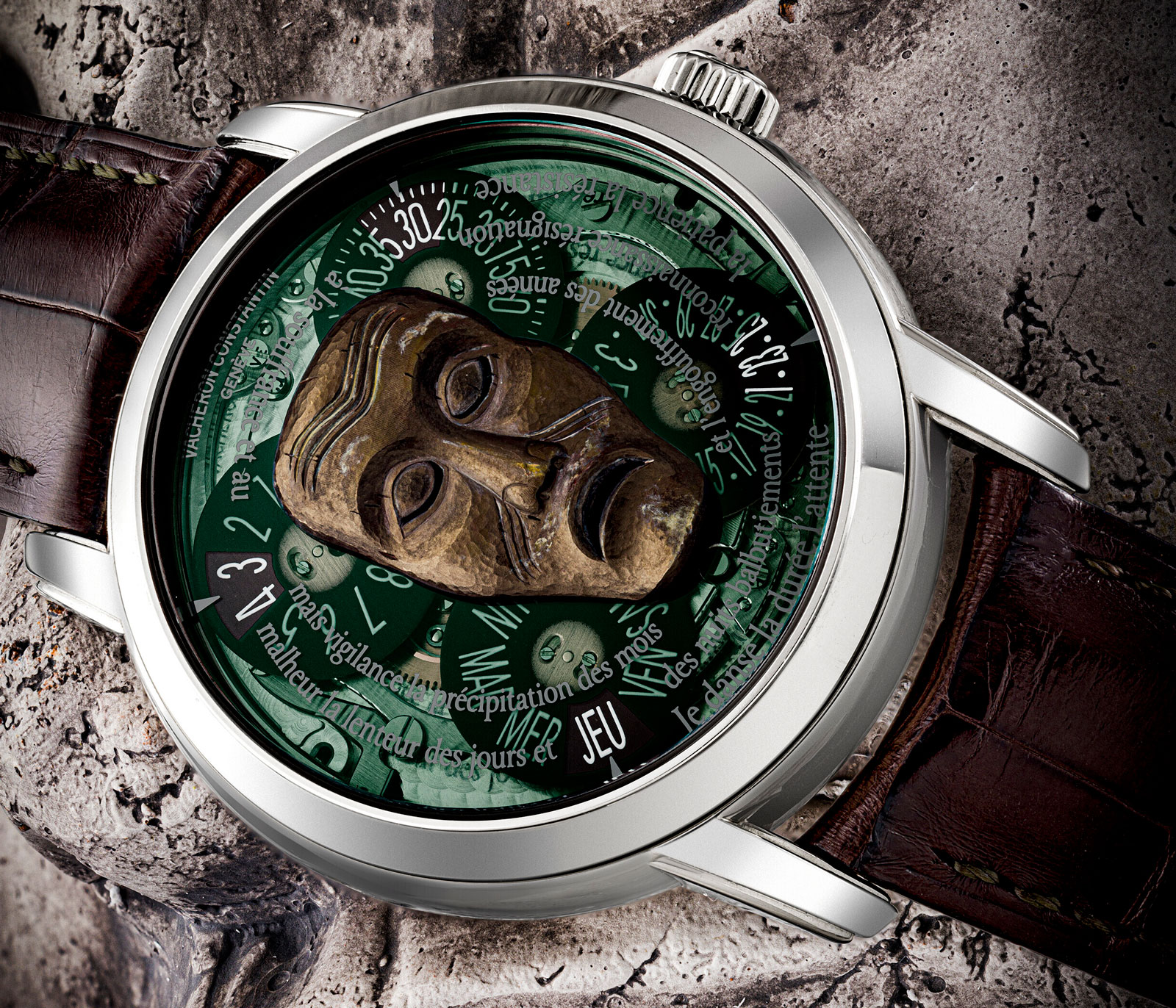
Lastly, the Mask of China represents a golden facial mask discovered in the Tibetan region of China and employed by practitioners of Tantric Buddhism dating back to the 16th and 17th centuries. It is housed in an 18k yellow gold case. Full lot details here.
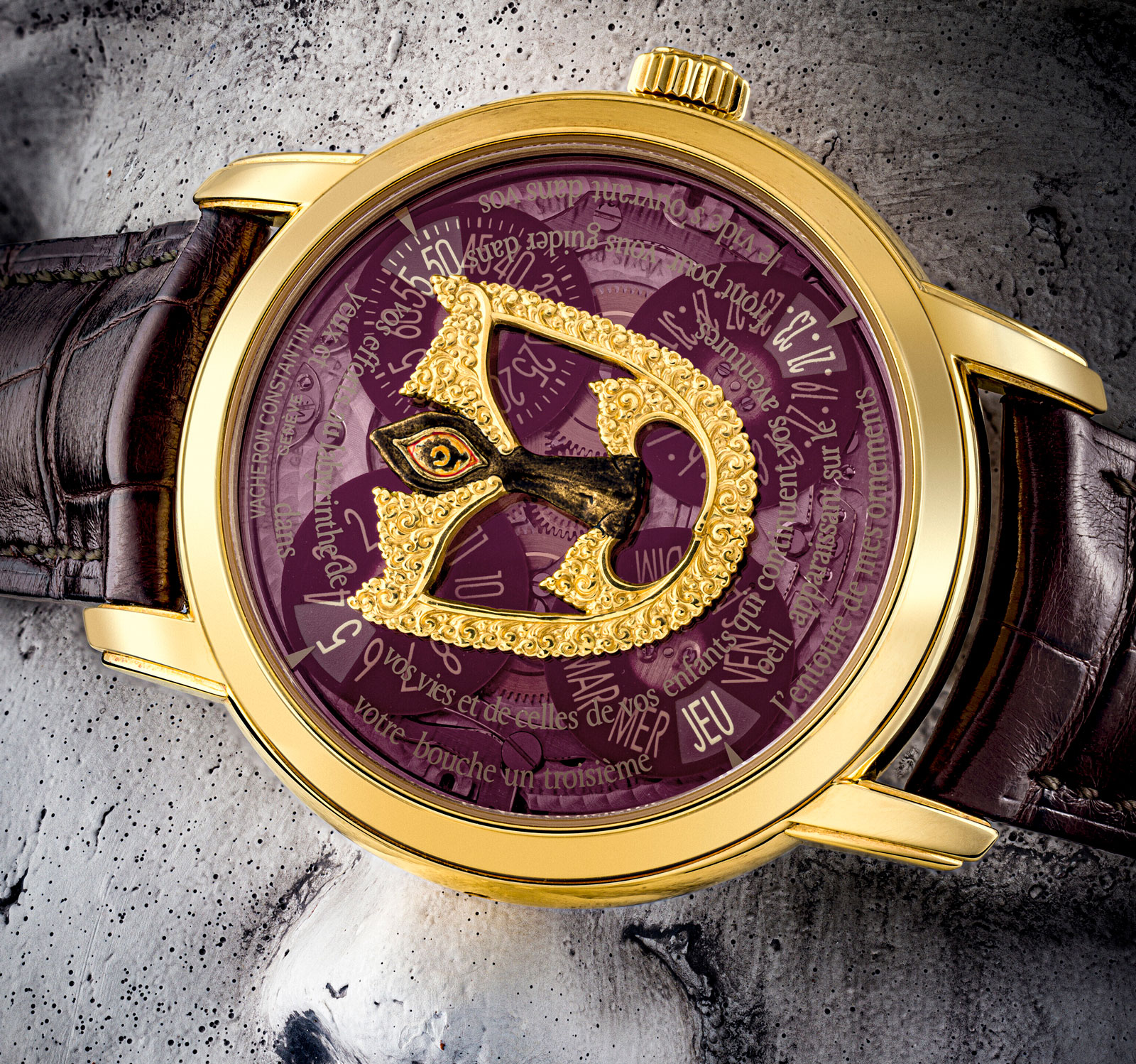
All four watches were originally sold as a set in a black wooden presentation box; the box is now offered separately as Lot 2228 with an estimate of HK$8,000-16,000, or about US$1,020-2,050. If all four watches are won by the same bidder, the box will be given to the bidder at no cost.
Lot 2303: Patek Philippe Rare Handcrafts ref. 5088/100P-001 “Volutes and Arabesques”
As Patek Philippe Rare Handcraft Calatravas go, this ref. 5088 is one of the most accessible. The brand has made several editions in this style, in both Calatrava and Golden Ellipse cases, making them relatively more common and thus more affordable.
The flanks of the case and dial are both engraved with Arabesque and volute motifs that are then filled with black fired enamel – a technique known as champleve – to create an ornate, high-contrast aesthetic.
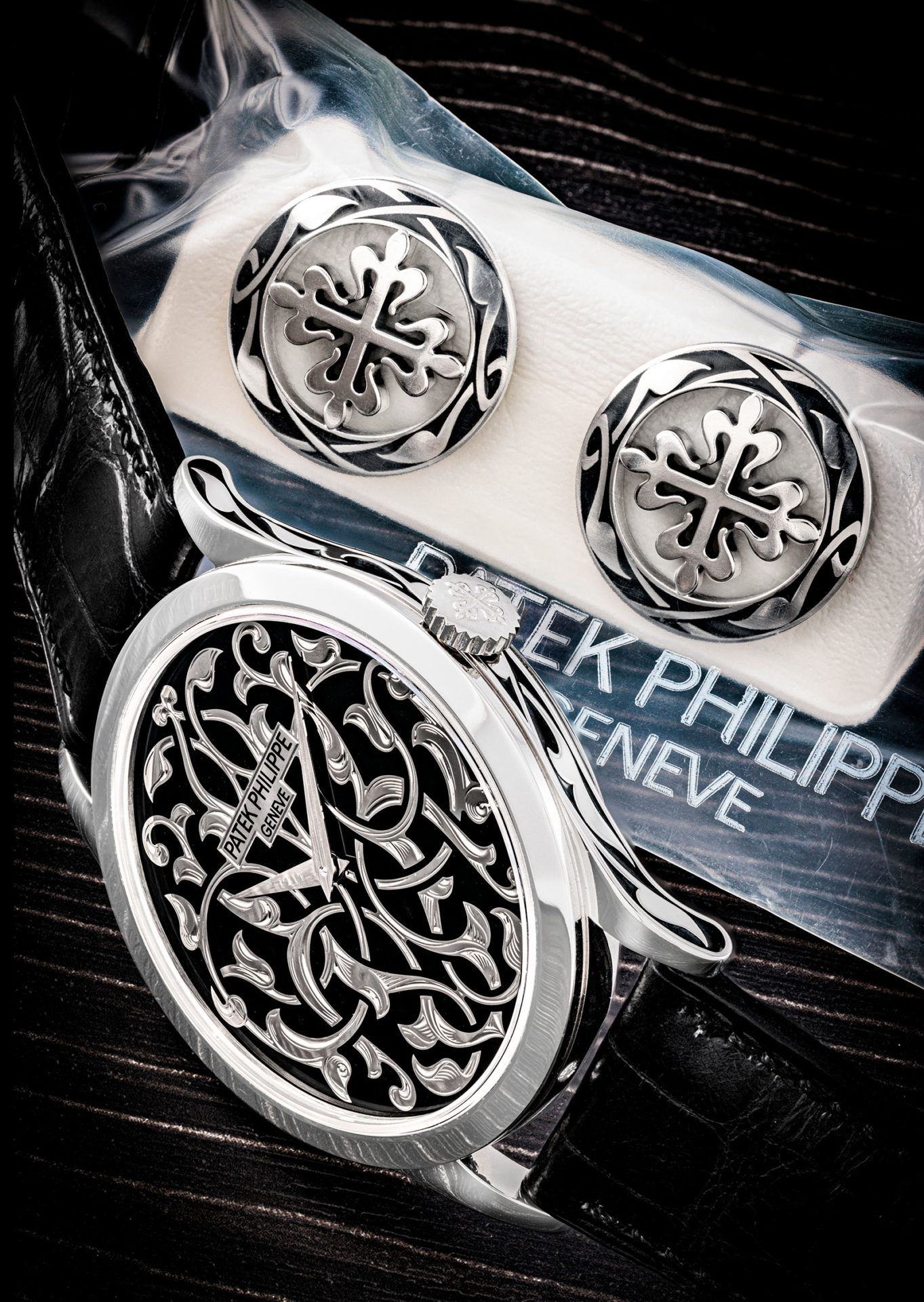
It is housed in a platinum Calatrava-style case with a diameter of 38 mm containing the automatic cal. 240. According to Christie’s, this particular example is fresh to market, with fewer than 10 known to exist.
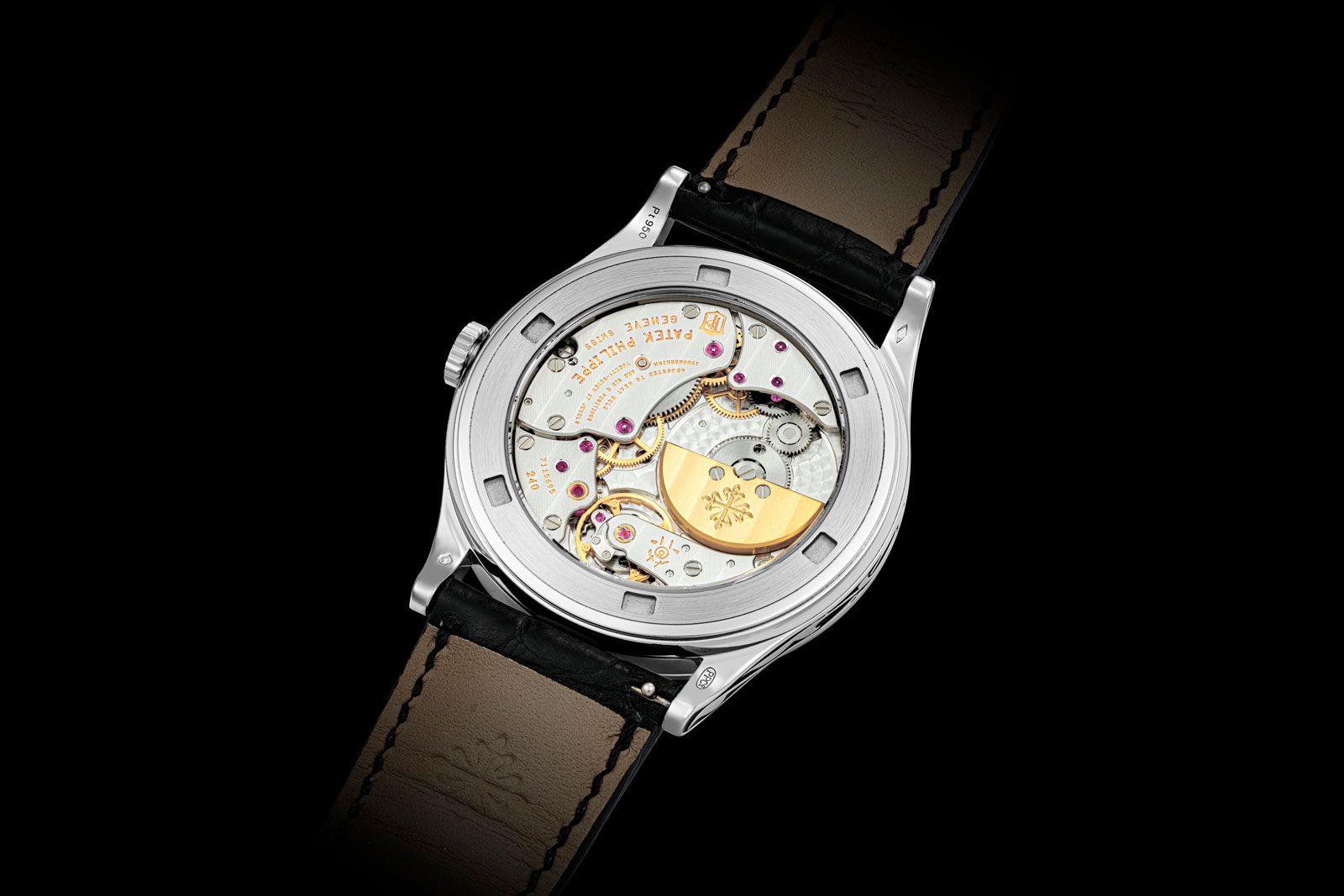
The ref. 5088 is accompanied by its original presentation box and accessories including a pair of 18k white gold cufflinks decorated in the same style as the watch. It carries an estimate of HK$300,000-600,000, or about US$38,400-77,000.
For more, view the catalogue entry.
Lot 2330: Patek Philippe Rare Handcrafts “Lighthouses of France” ref. 5089G-121
Patek Philippe Rare Handcrafts wristwatches possess a varied charm because of the diversity of decoration and style. Particularly striking with its depiction of a lighthouse against a cinematic backdrop of a gathering storm, this ref. 5089G is one of four watches of the “Lighthouses of France” series.
Like many Rare Handcrafts Calatravas, this has a dial of cloisonné. The enamelling is inspired by the 19th-century La Vieille lighthouse off the coast of Brittany and portrays the lighthouse standing resolute as waves crash against it.
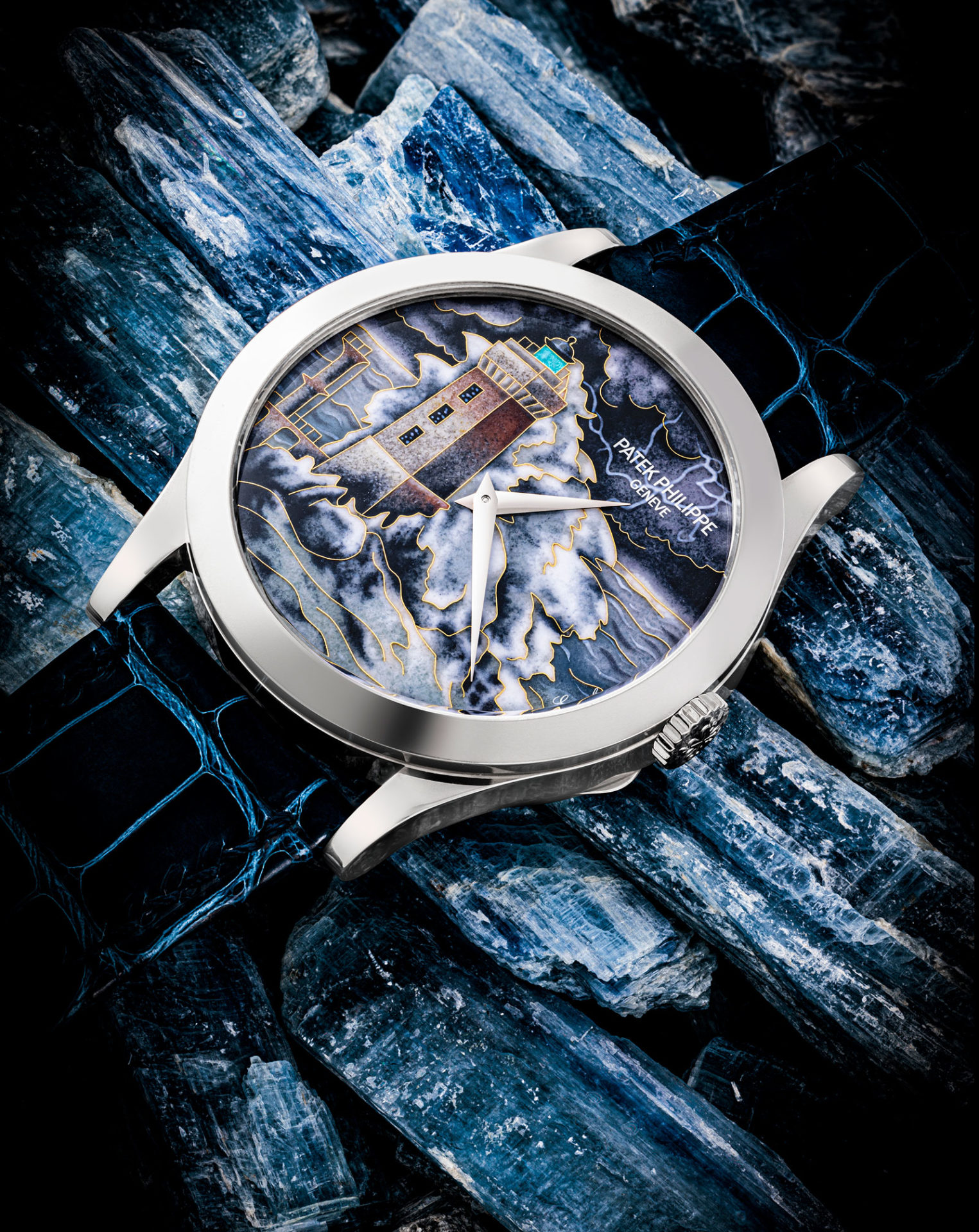
Similar to other time-only Rare Handcrafts wristwatches, the ref. 5089G is housed in the standard Calatrava case with a diameter of 38.5 mm. It is powered by the cal. 240 visible through a hinged case back.
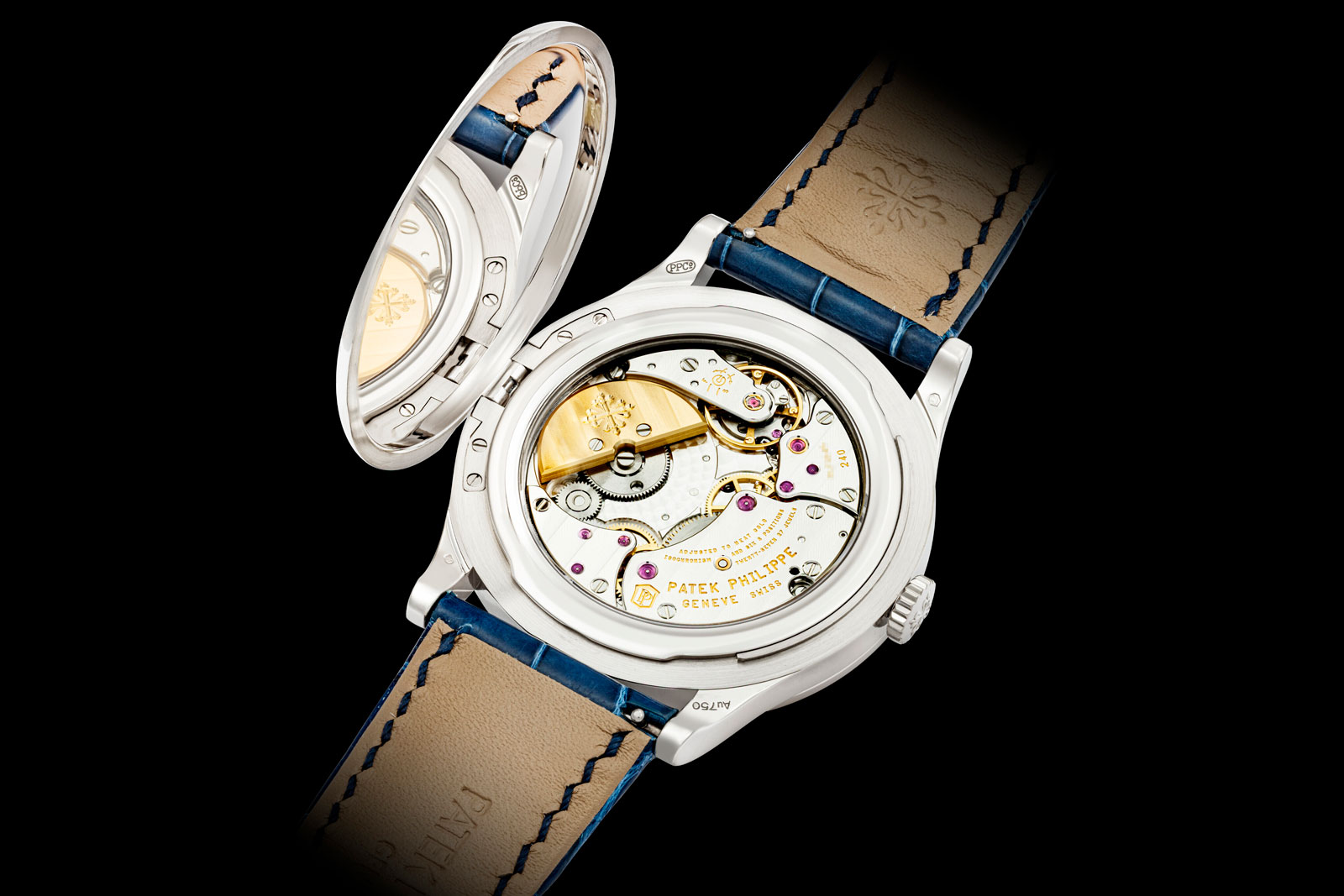
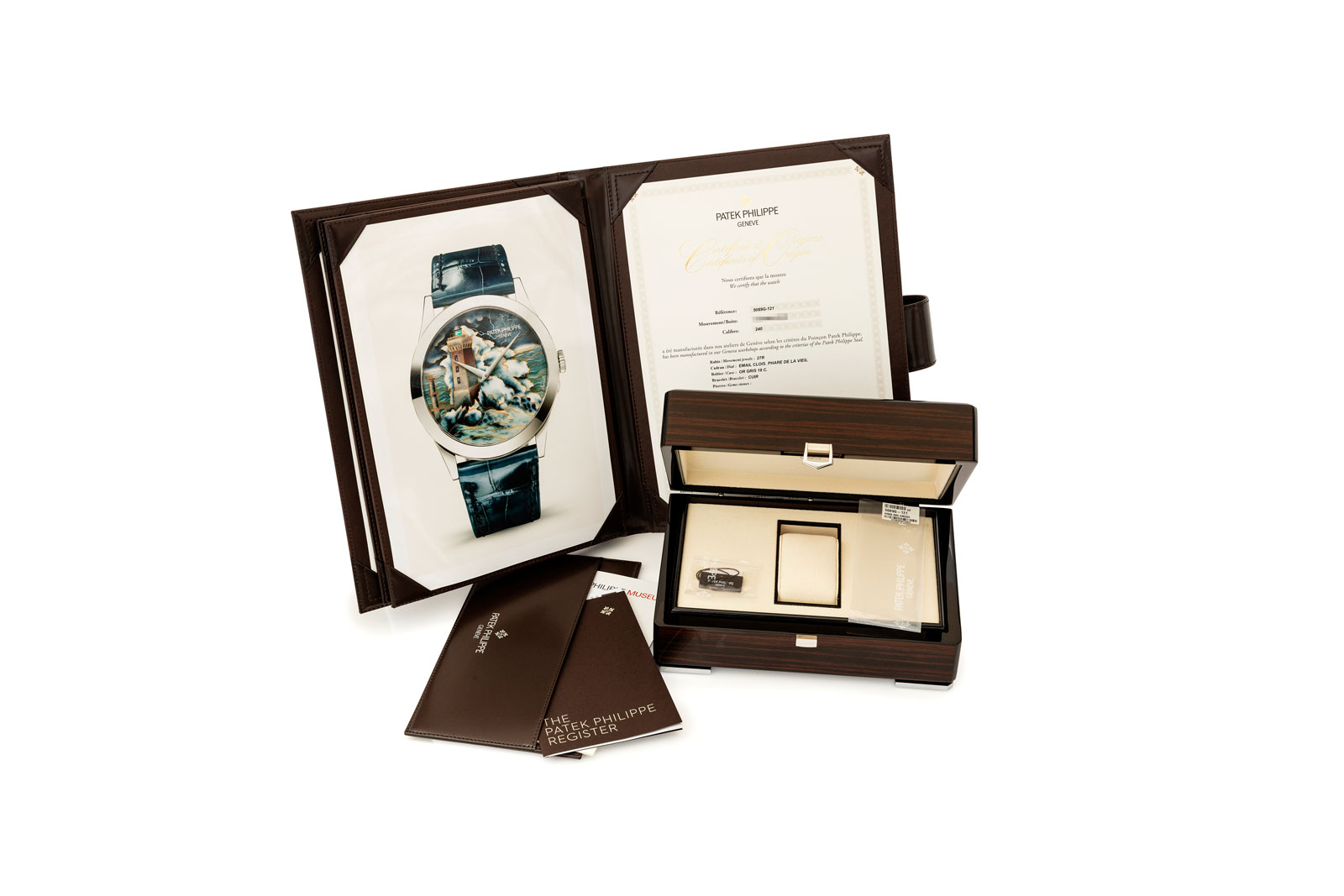
This particular example is offered as a complete set including the certificate in a leather folder. It carries an estimate of HK$600,000-1.2 million, or about US$77,000-154,000.
For more, view the catalogue entry.
Lot 2336: Patek Philippe World Time Minute Repeater ref. 5531R-012
The ref. 5531R was both a landmark in terms of mechanics and decoration. It was Patek Philippe’s first minute repeater with a world time. And it was also the first world time watch to sport both a hobnail guilloche case band and cloisonné enamel dial.
Unveiled first as a limited edition in 2017, the reference has subsequently become a regular production model, albeit one that is exceedingly hard to obtain. This example is one of the regular production models and depicts a classical scene showing the Lavaux vineyards on the shores of Lake Geneva, with traditional sailboat on the water as the sun sets over the lake.
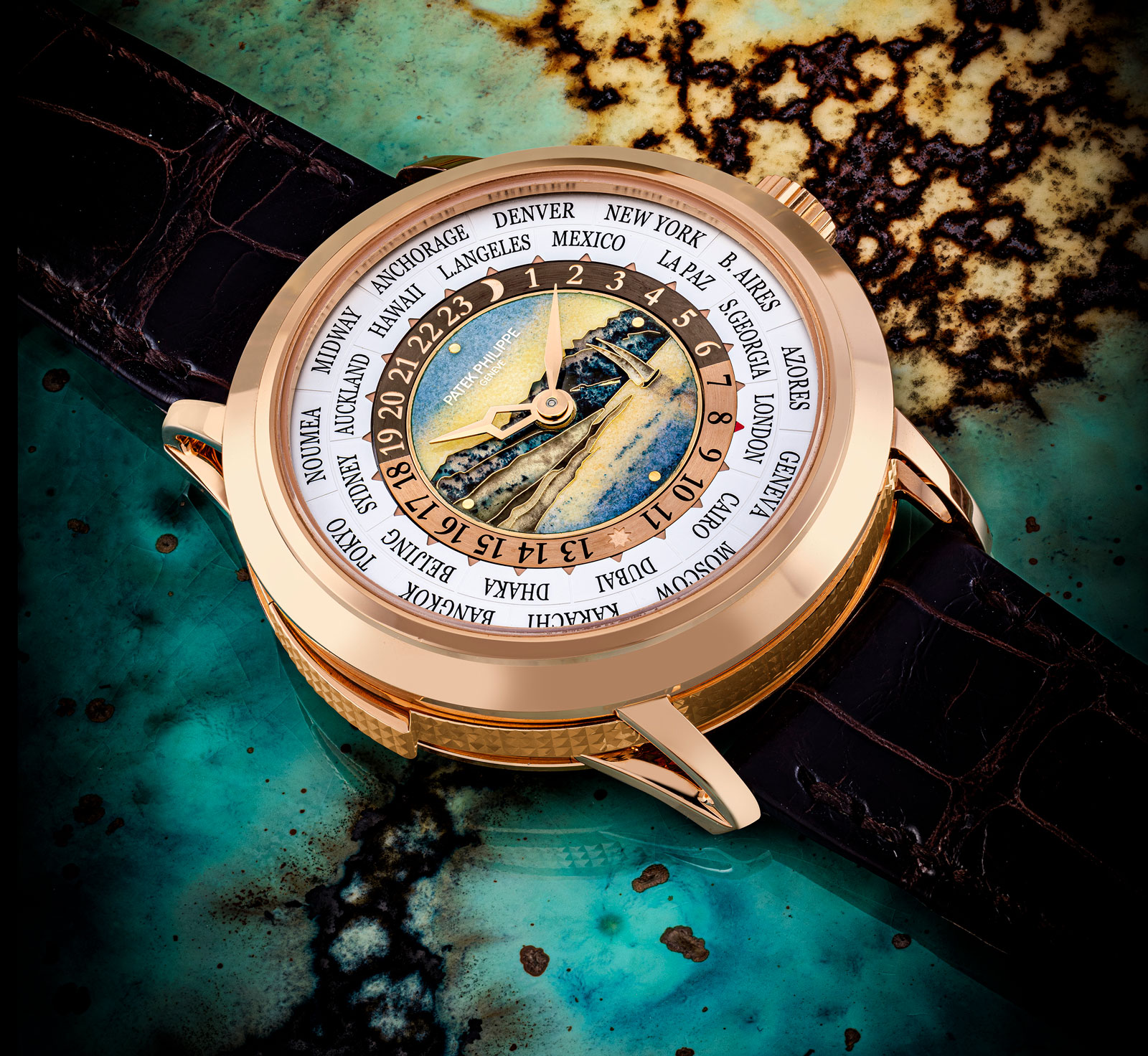
The 40 mm rose gold case featuring a hobnail decoration along its sides and also on the minute repeater slider. It is powered by the cal. R 27 HU, which is made up of Patek Philippe’s longstanding self-winding repeater calibre with the world time module on the top.
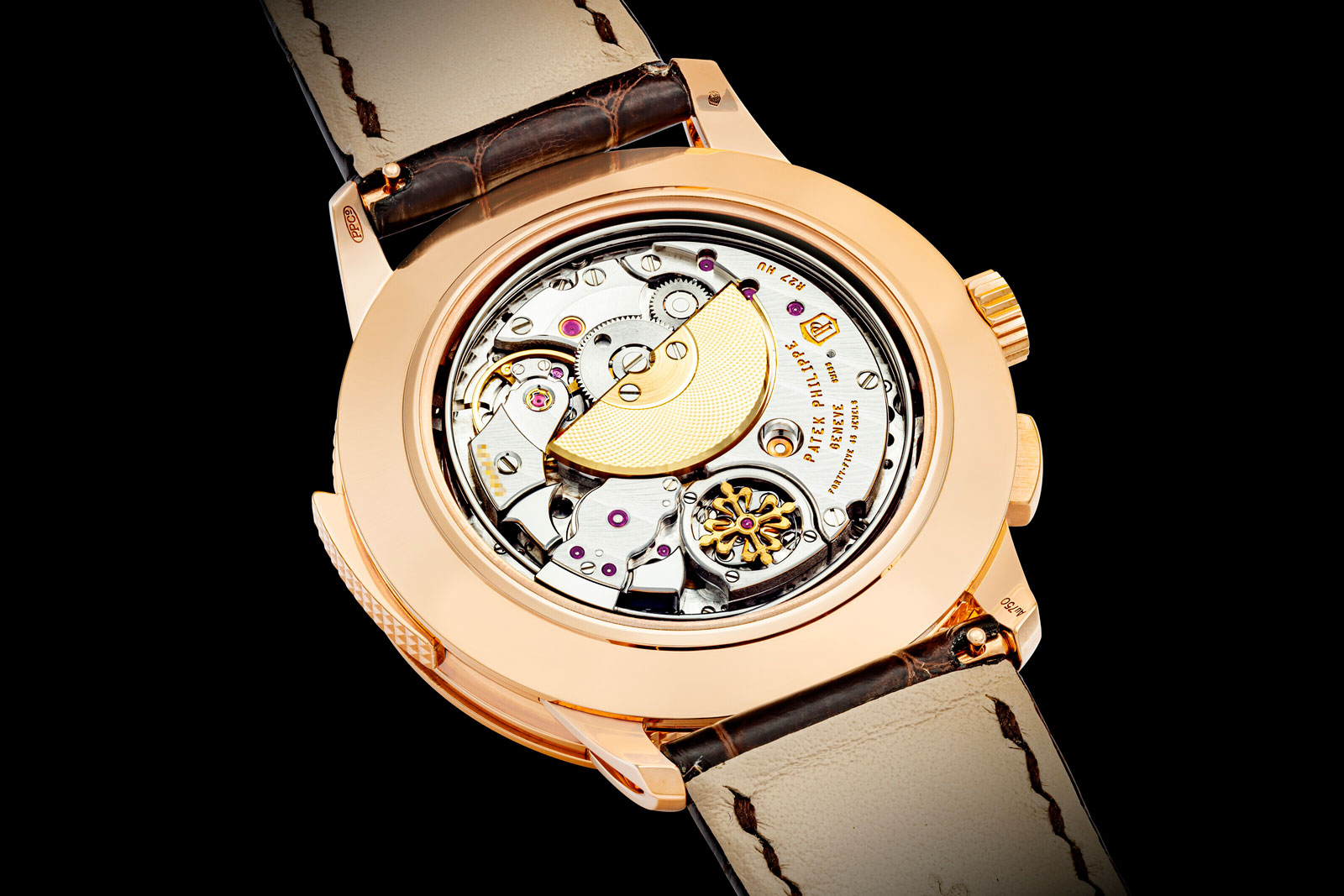
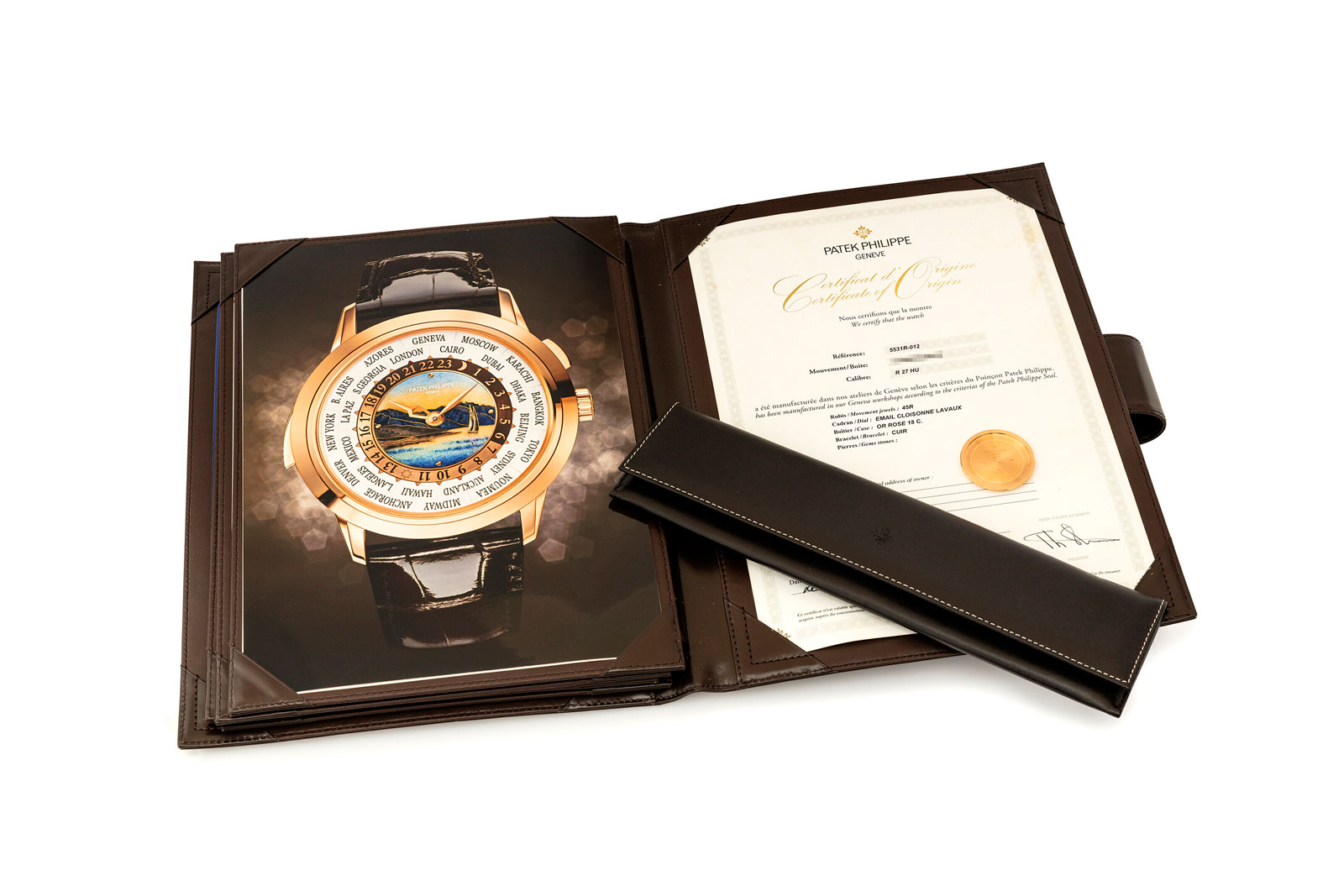
The present lot is offered as a complete set and carries an estimate of HK$8.4-16 million, or about US$1.08-1.54 million.
For more, view the catalogue entry.
Lot 2588 (OAK Collection): Voutilainen Vingt-8
Launched in 2011, the Vingt-8 has become the cornerstone of Voutilainen’s line-up. While many one-off variants of the model have been made, this example is particularly interesting for its dial design.
Done in red champleve enamel, the dial features a puzzle-like chequerboard pattern that’s a departure from the typically traditional patterns found on most Vingt-8 specimens. Because the squares of the pattern vary in size, they lend an intriguing perspective to the dial.
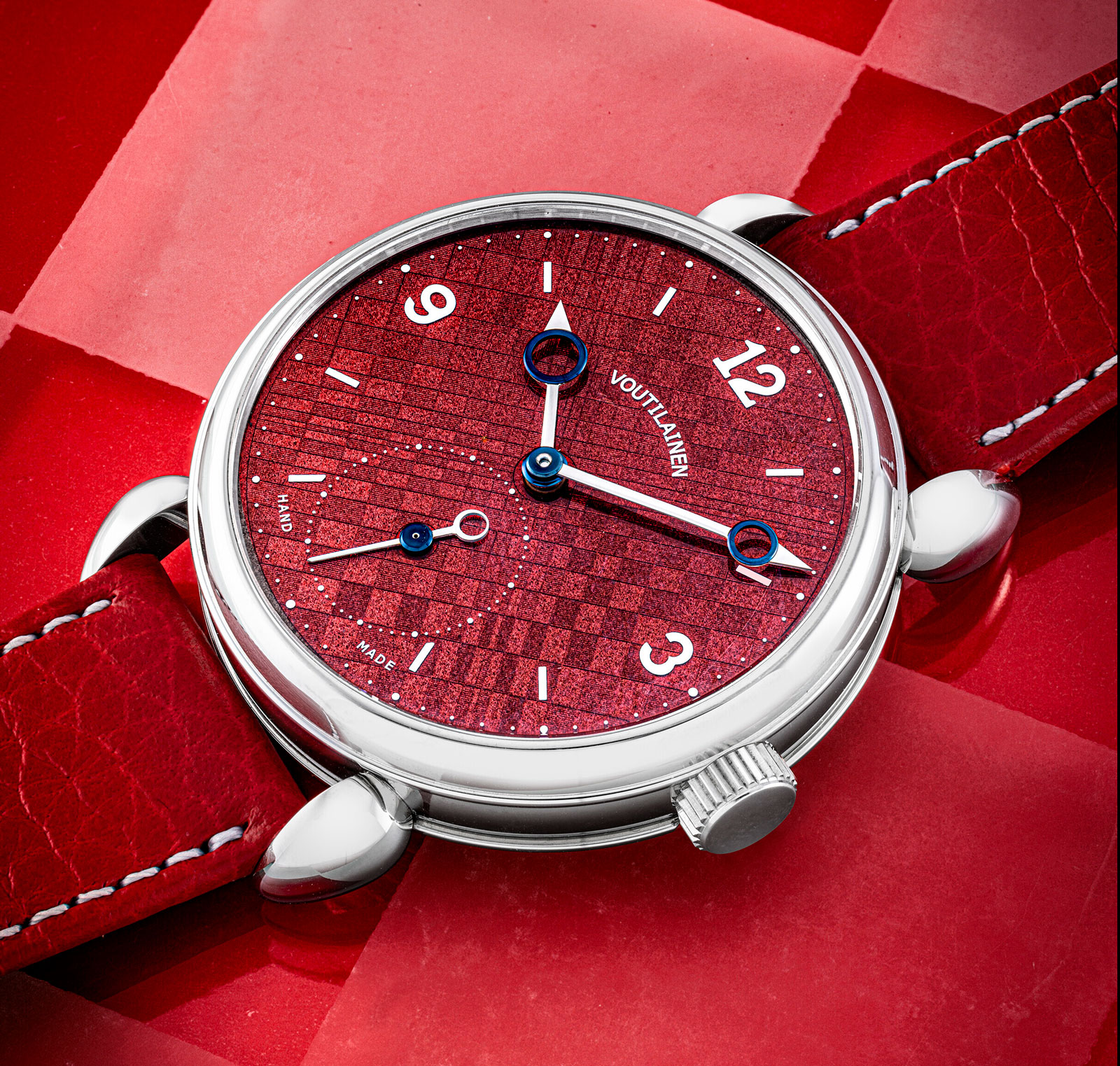
Unusually, the case is stainless steel and also notable for being marked “unique piece” on the back. Aside is the cal. 28 with frosted bridges and a dark grey finish, a muted aesthetic that contrasts against the red dial.
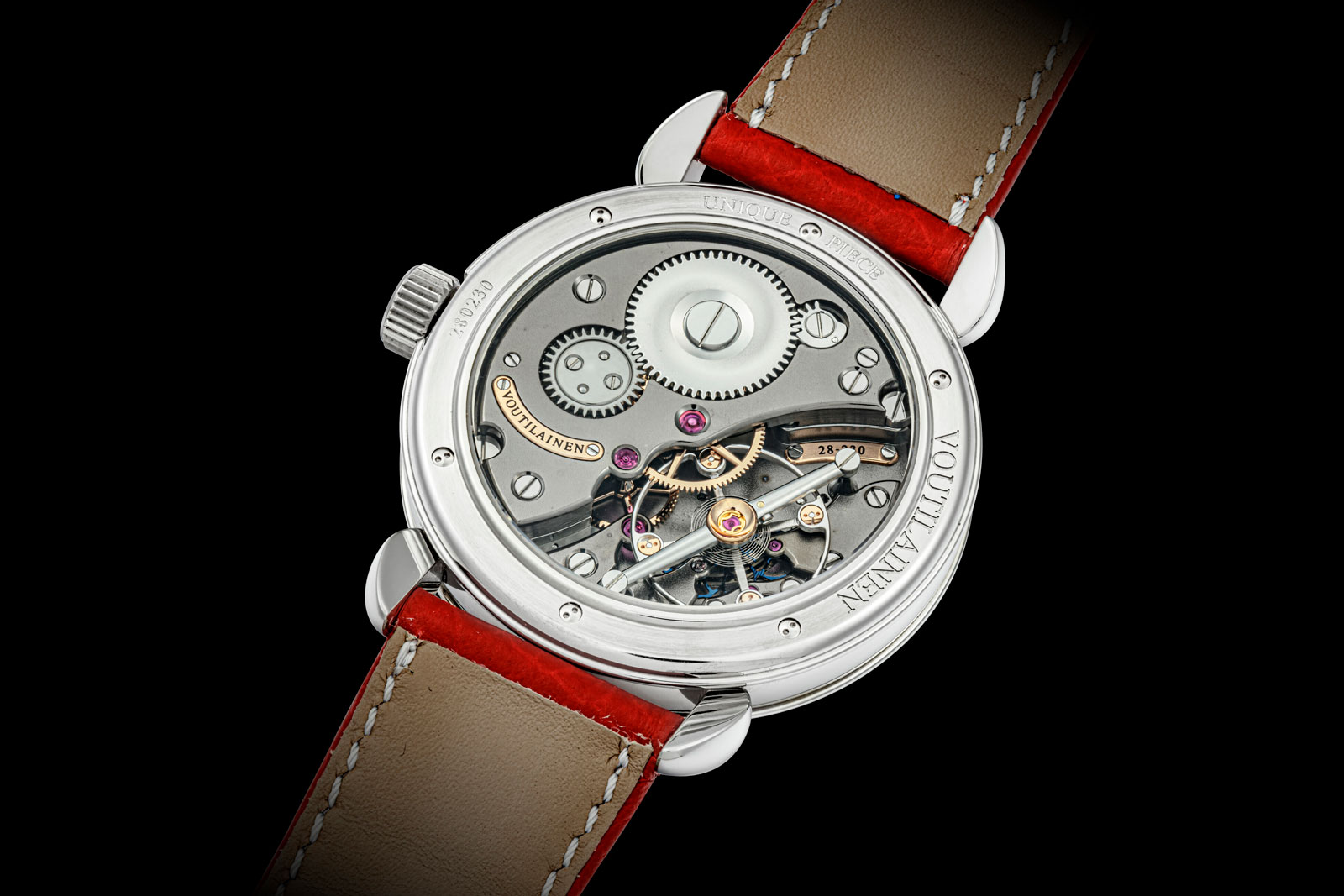
This watch incudes its original certificate and a spare buckle. It carries an estimate of HK$2.0-4.0 million, or about US$256,400-512,800. Full lot details here.
Lot 2616 (OAK Collection): Patek Philippe Rare Handcrafts “Lac Blanc” pocket watch ref. 992/108J-001
Amongst the most impressive of Patek Philippe’s Rare Handcrafts offerings are the enamelled pocket watches delivered with matching solid-gold stands.
This is one such example that depicts the Mont Blanc massif as seen from Lac Blanc in France. The mountains are depicted in cloisonné enamel, while the vibrant sky and clear waters are in flinque enamel, which is translucent enamel over an engraved surface. It is a very traditional Swiss scene, but one depicted in uncommonly bright colours.
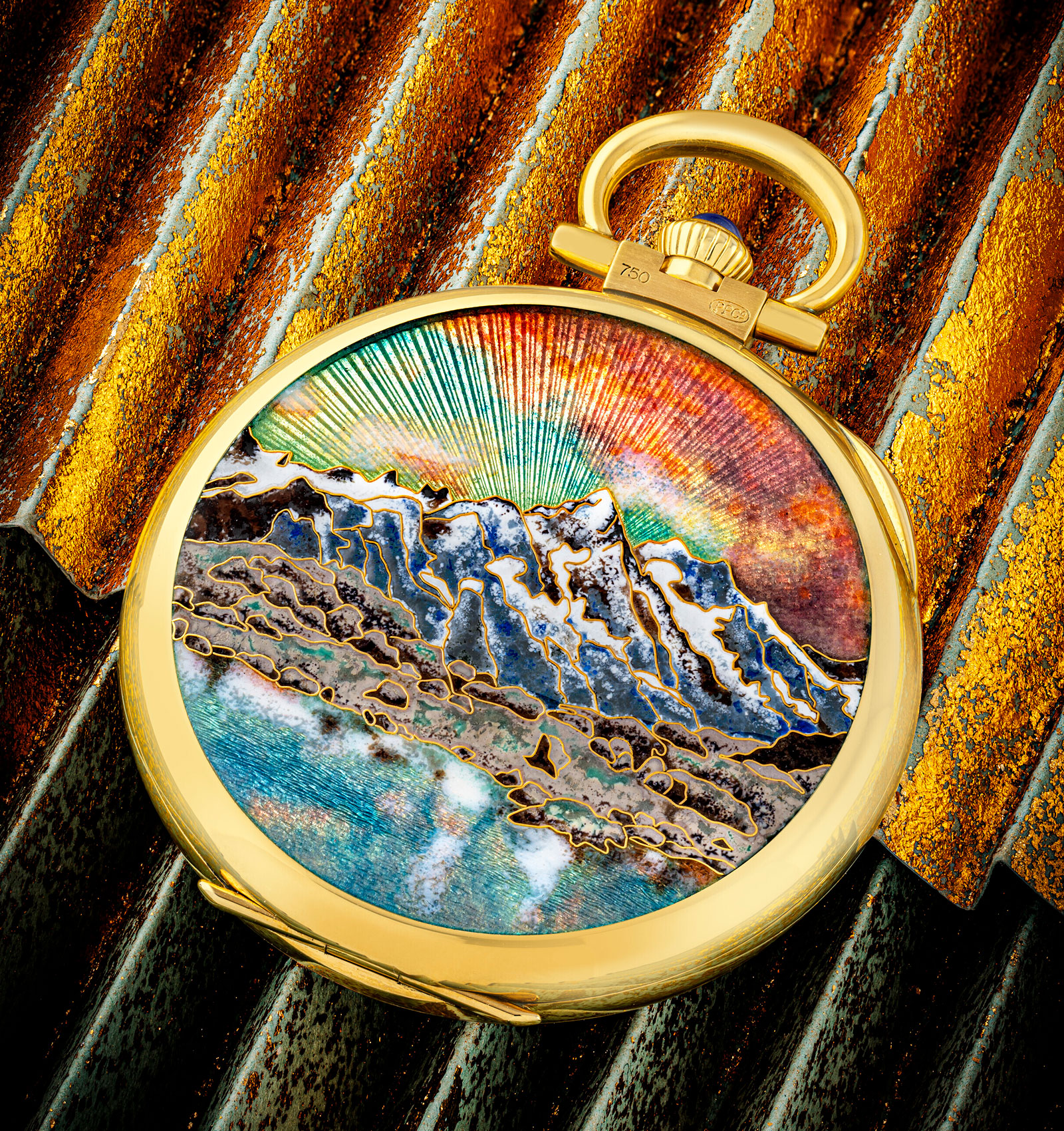
The front is a simpler affair of white enamel with applied Breguet numerals. And inside is the manually wound cal. 17′” LEP PS.
Almost as impressive as the watch is the matching stand in 18k yellow gold decorated with flowers and sitting on a white marble base.
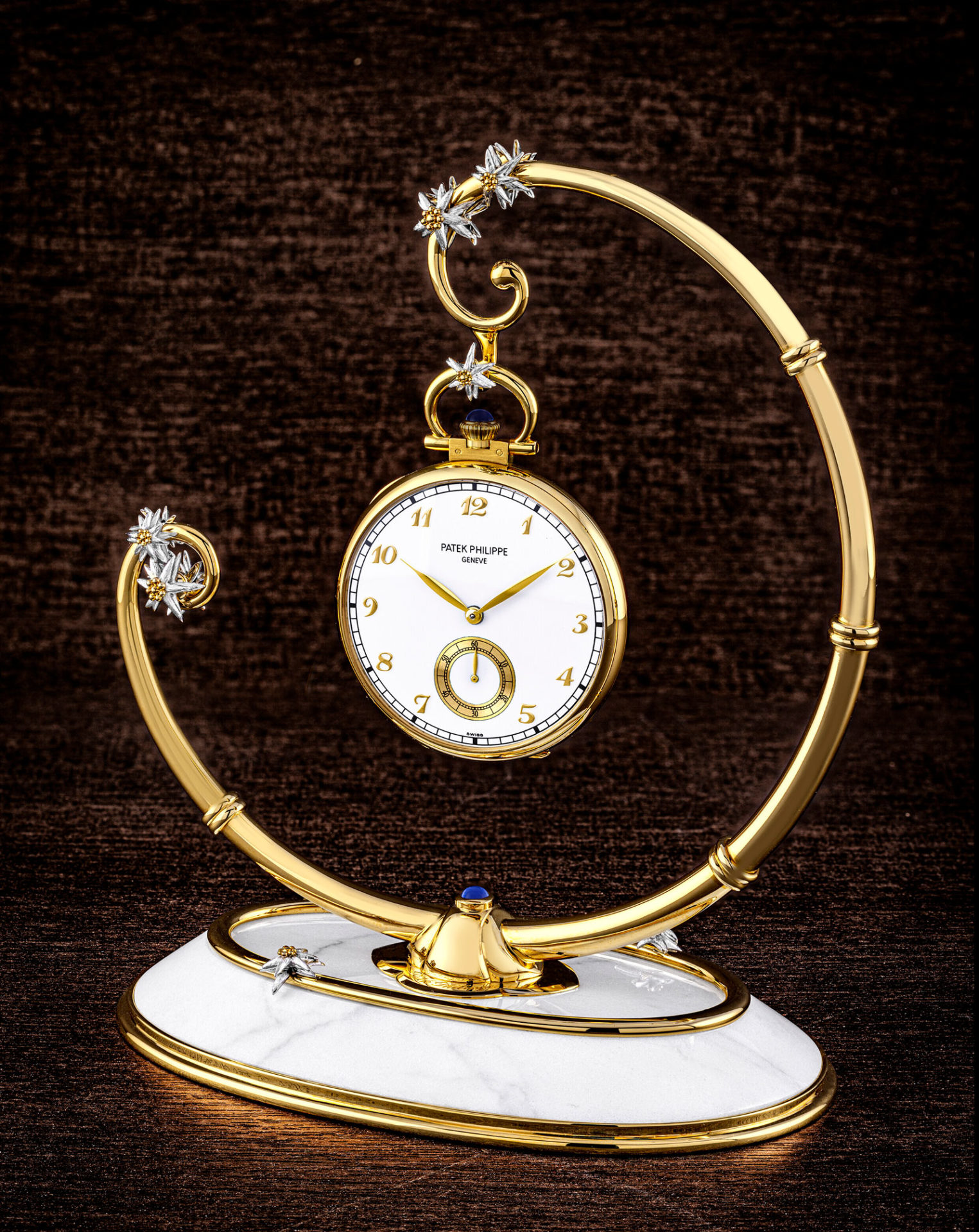
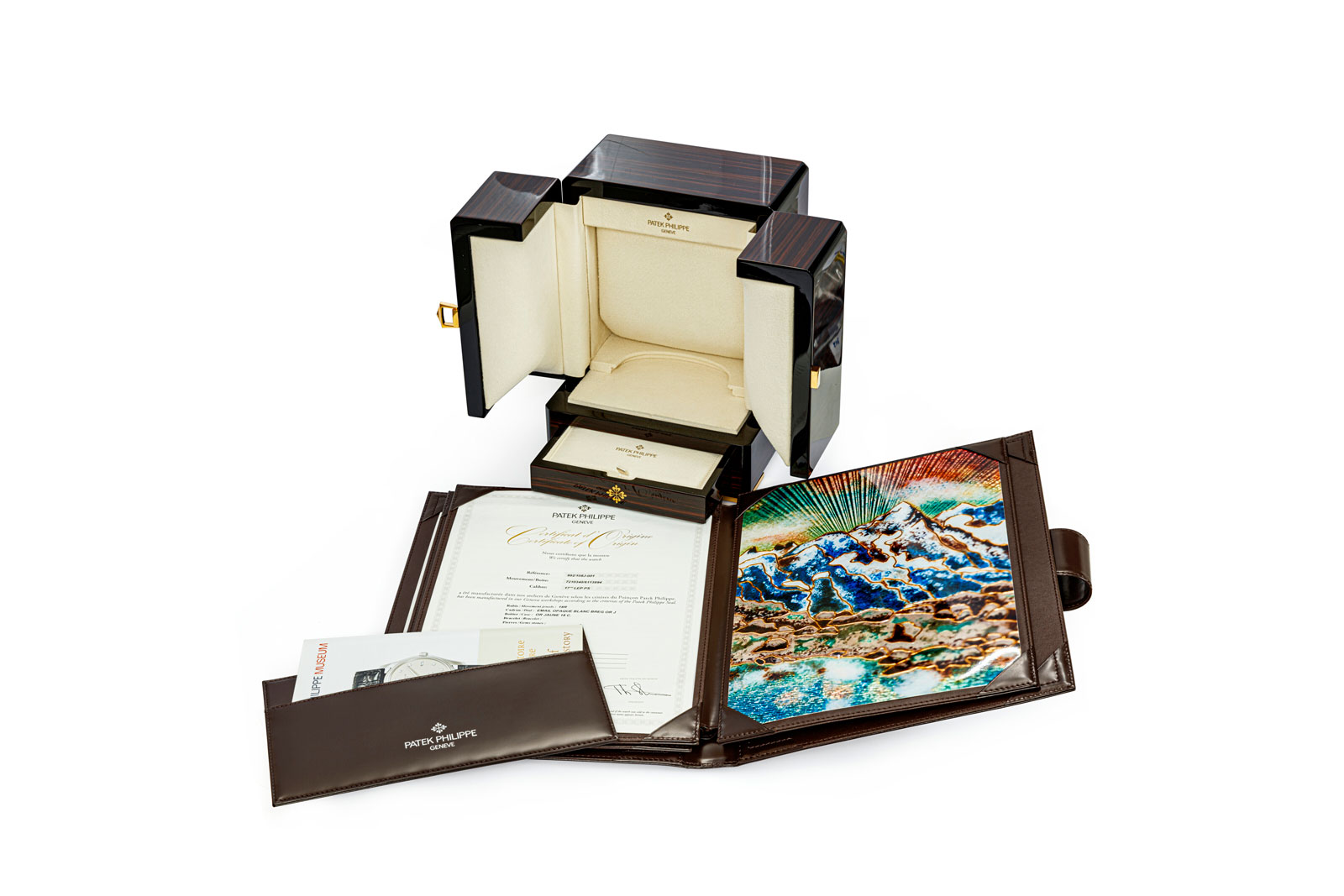
This particular example is offered as a complete set and has an estimate of HK$2.0-4.0 million, or about US$256,400-512,800.
For more, visit the catalogue.
Lot 2617 (OAK Collection): Patek Philippe Dome Clock ref. 1636M-001 “Early Hot Air Ballons”
As vividly coloured as the pocket watch above, but on a far larger scale, the Dome Clock ref. 1636M-001 depicts hot air balloons over a formal French garden in the 18th century.
The whimsical scenes are found on several surface of the clock save for its bottom, and all are rendered in cloisonné enamel that’s the work of Swiss enameler Jeremie Basset.

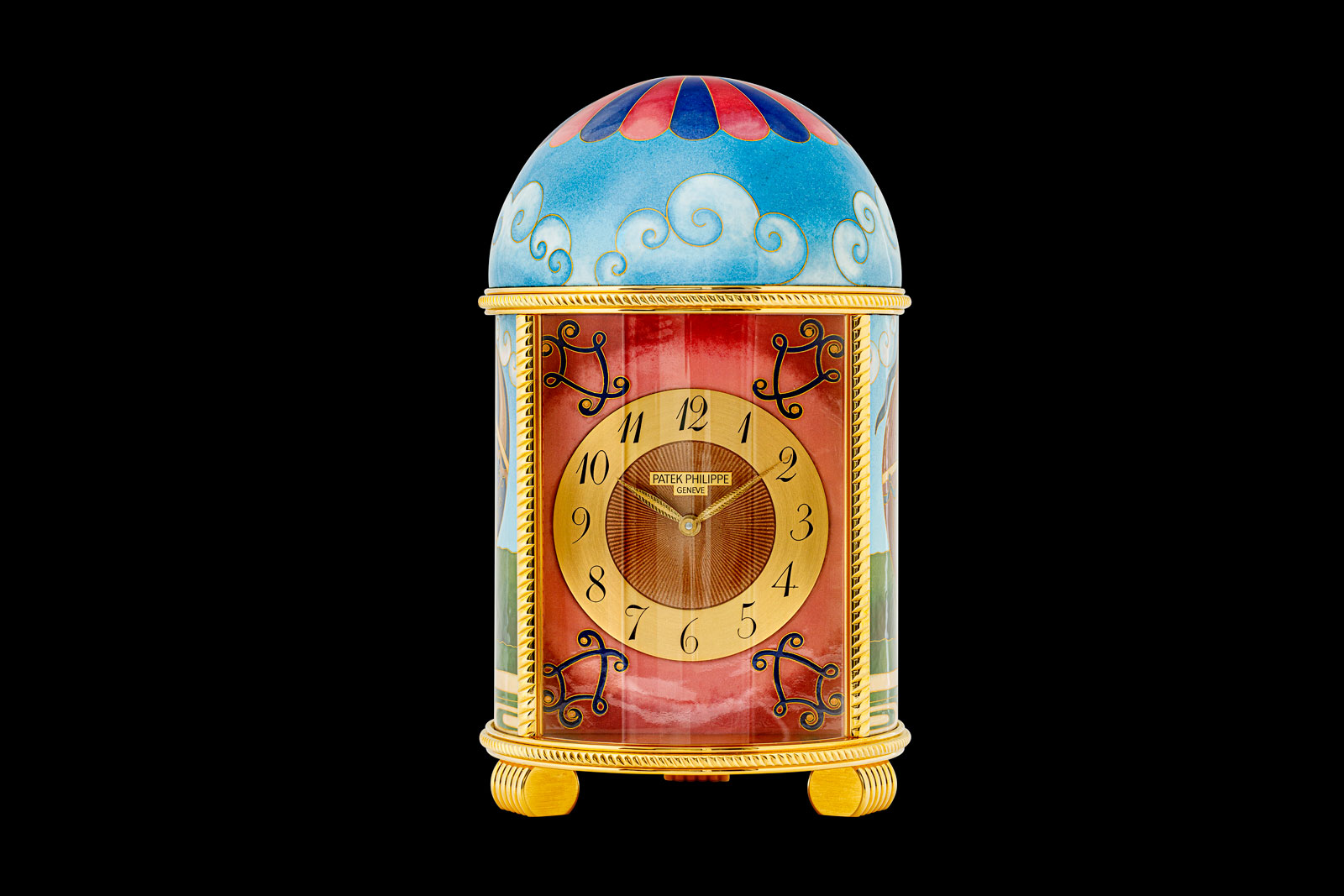

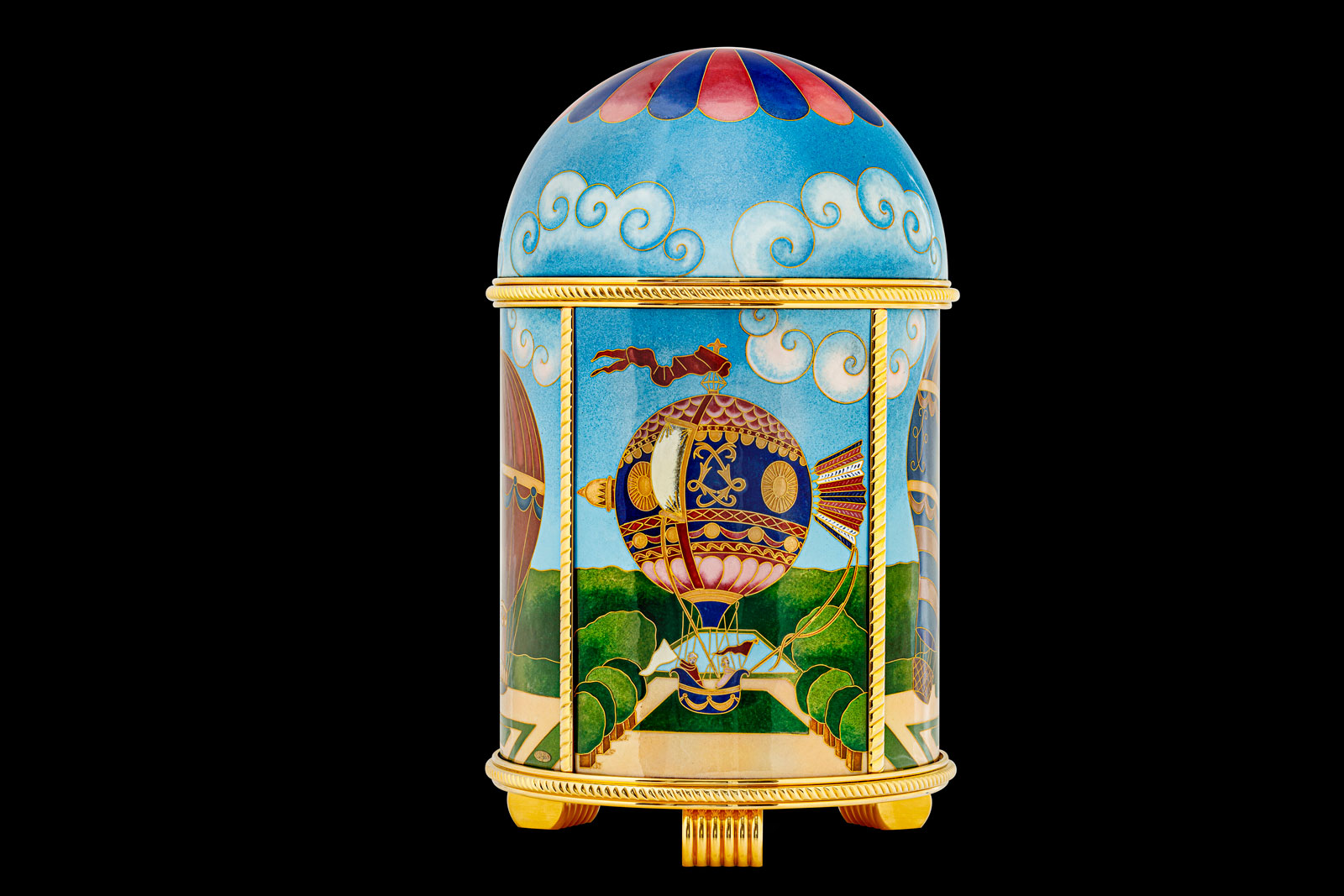
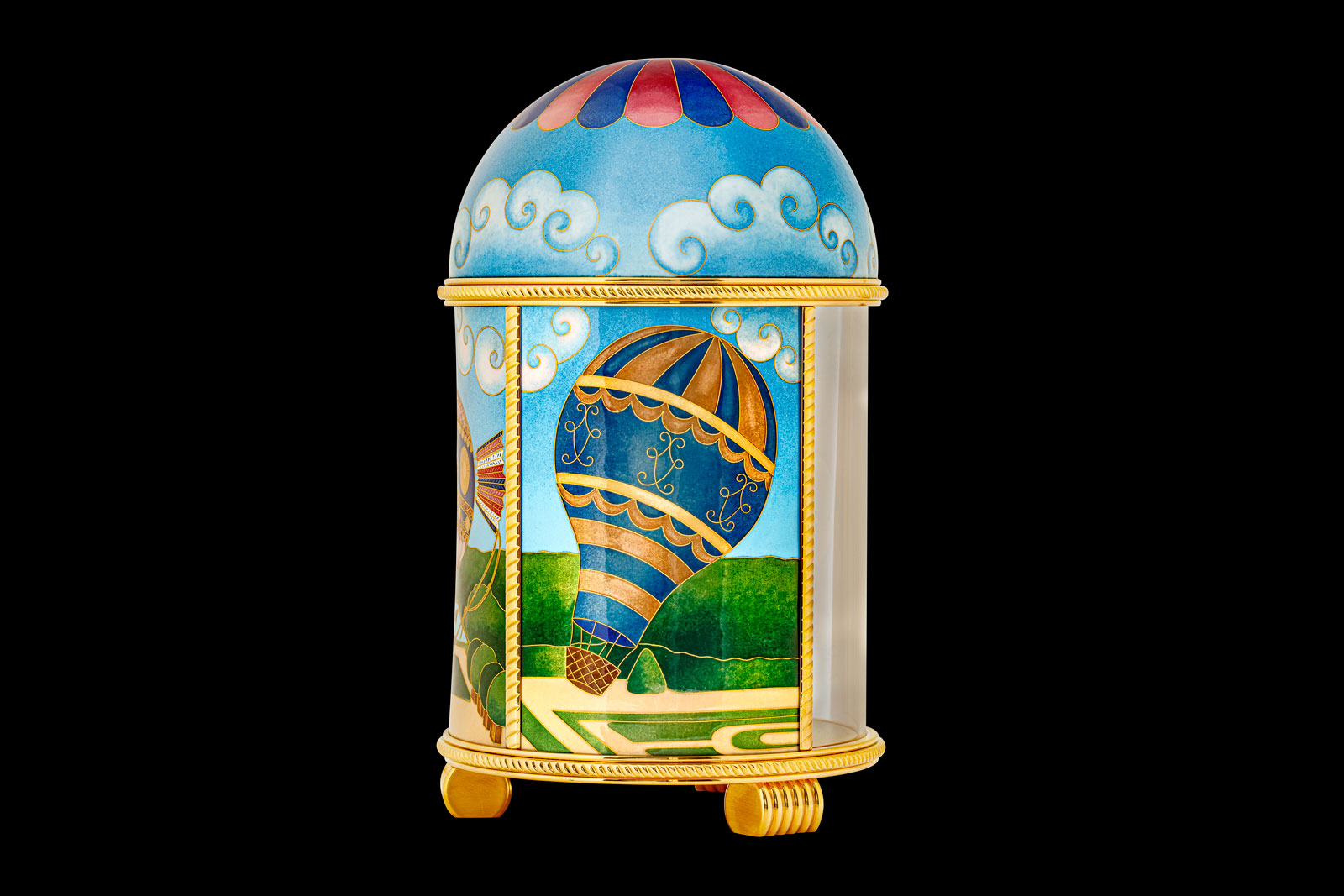
Fresh to the market and in excellent condition, this clock was made in 2015 and is amongst the most visually striking of Dome Clocks thanks to its colours and motif.
Like all modern-day Dome Clocks it is powered by a manual-wind pocket watch movement that is automatically rewound by a quartz motor.
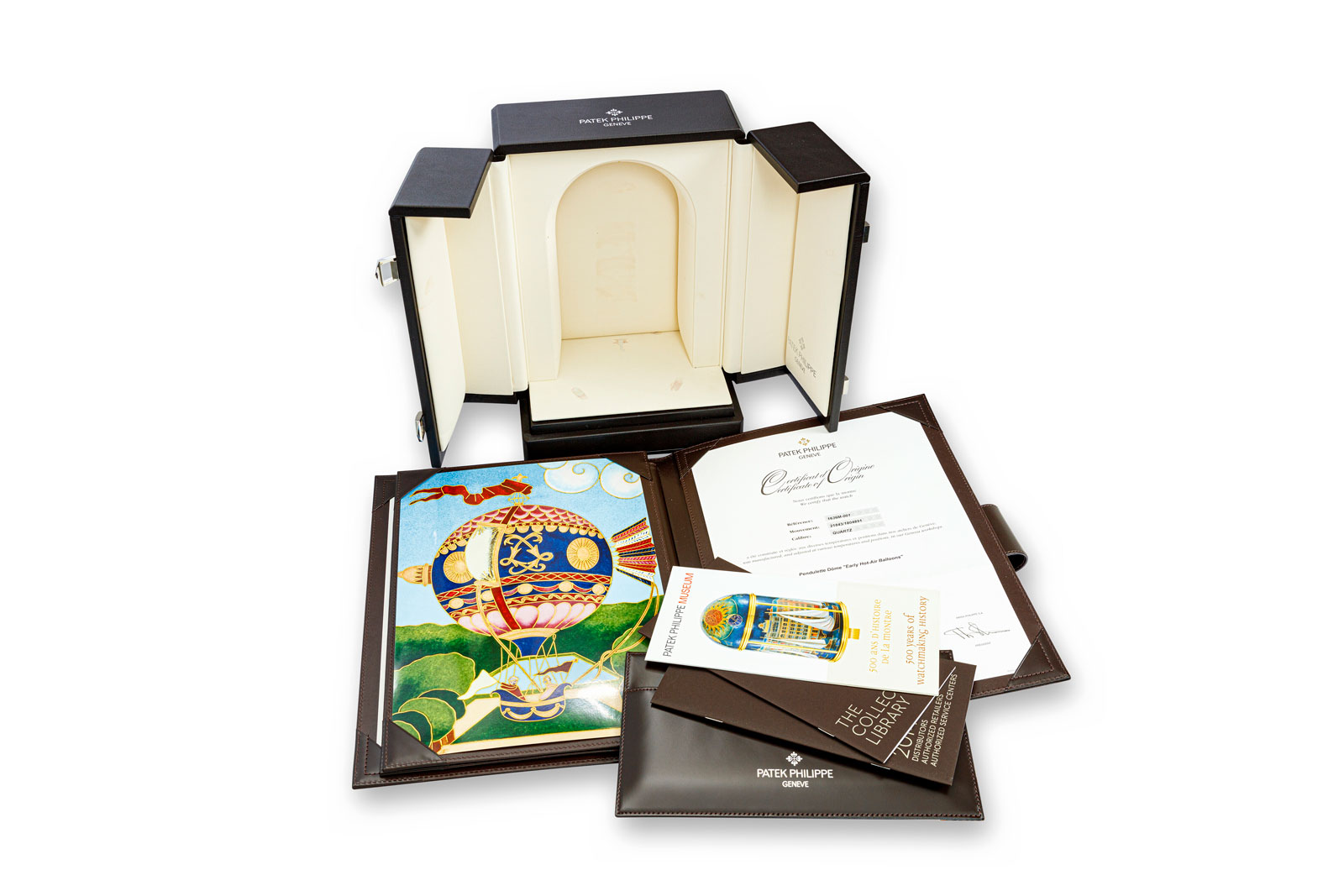
The clock includes a presentation box, certificates and product literature. It carries an estimate of HK$1.0-2.0 million, or about US$128,200-256,400.
Full lot details here.
Lot 2633 (OAK Collection): Omega Seamaster ref. OT 2520 “Neptune”
Amongst the most expensive watches of their time, 1950s cloisonné dial wristwatches were offered by the leading brands of the period, including Patek Philippe, Rolex, and Omega.
This example is an Omega Seamaster with the “Neptune” cloisonné dial. It was first sold at auction in 2012 by the family of the original owner who originally acquired it in Guatemala on November 19, 1954, but the watch has managed to survive the decades in well preserved condition.
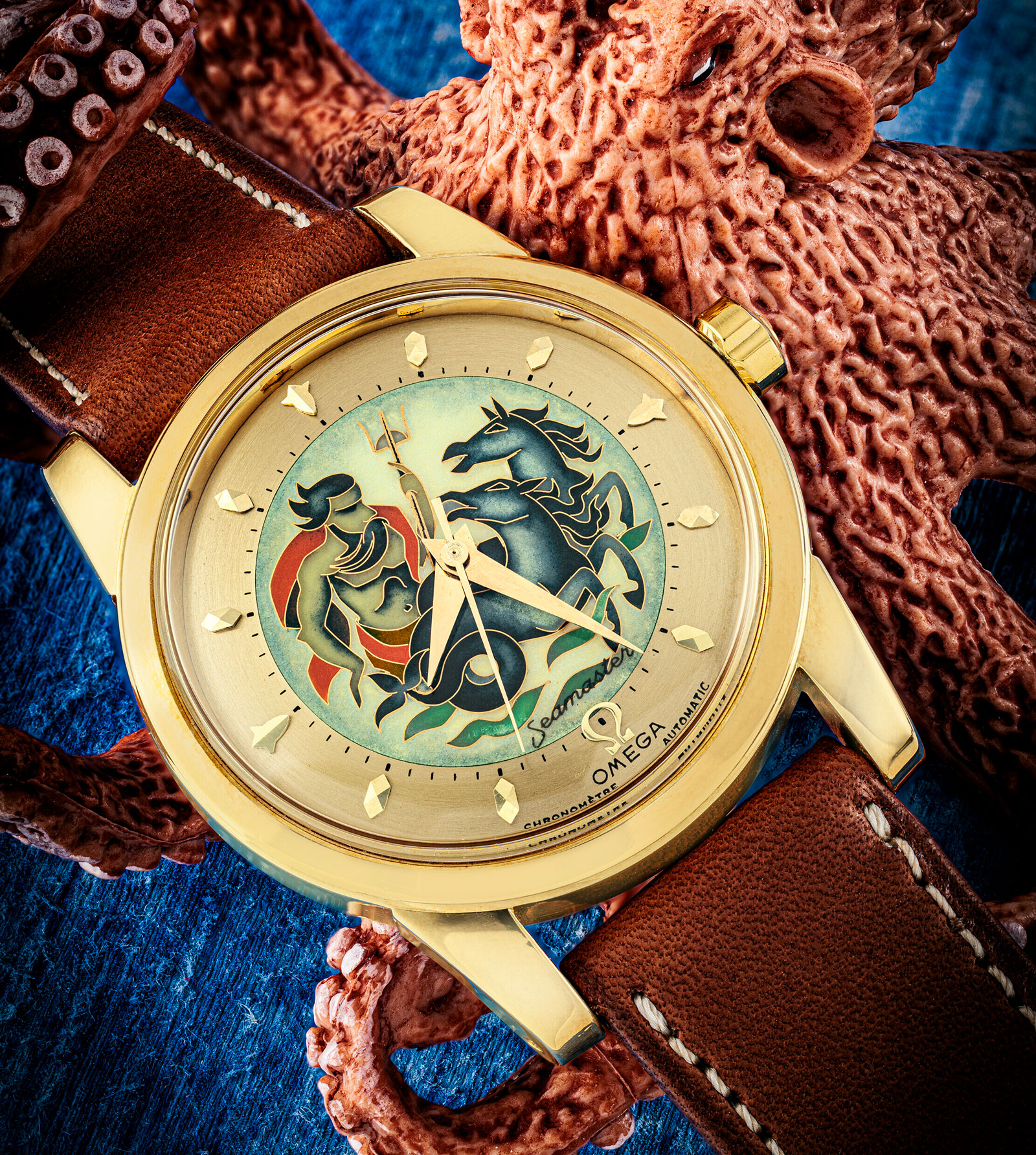
Like most fine cloisonné dials of the period, the “Neptune” dial was made by Fabrique de Cadrans Stern Frères of Geneva, the dial maker founded by the same family that today owns Patek Philippe.
According to Christie’s, Omega only received only five of these dials from Stern. The dials were all cloisonné on solid gold plates by Nelly Richard, amongst the leading enamelers of the time. Richard also produced dials for other brands, and the Neptune motif can be found in a handful of Rolex watches as well.
Produced between 1946 and 1956, Omega wristwatches with cloisonné enamel dials were some of the most expensive watches offered by the brand then. Furthermore, the “Neptune” dial ranked amongst the most complex, with Richard’s fee for making the dial being CHF86 francs per dial, with Omega in turn paying Stern Freres CHF155 per dial. In comparison, the public retail price of the ref. 1518, one of the most complicated wristwatches in the world at the time, was about CHF2,000.
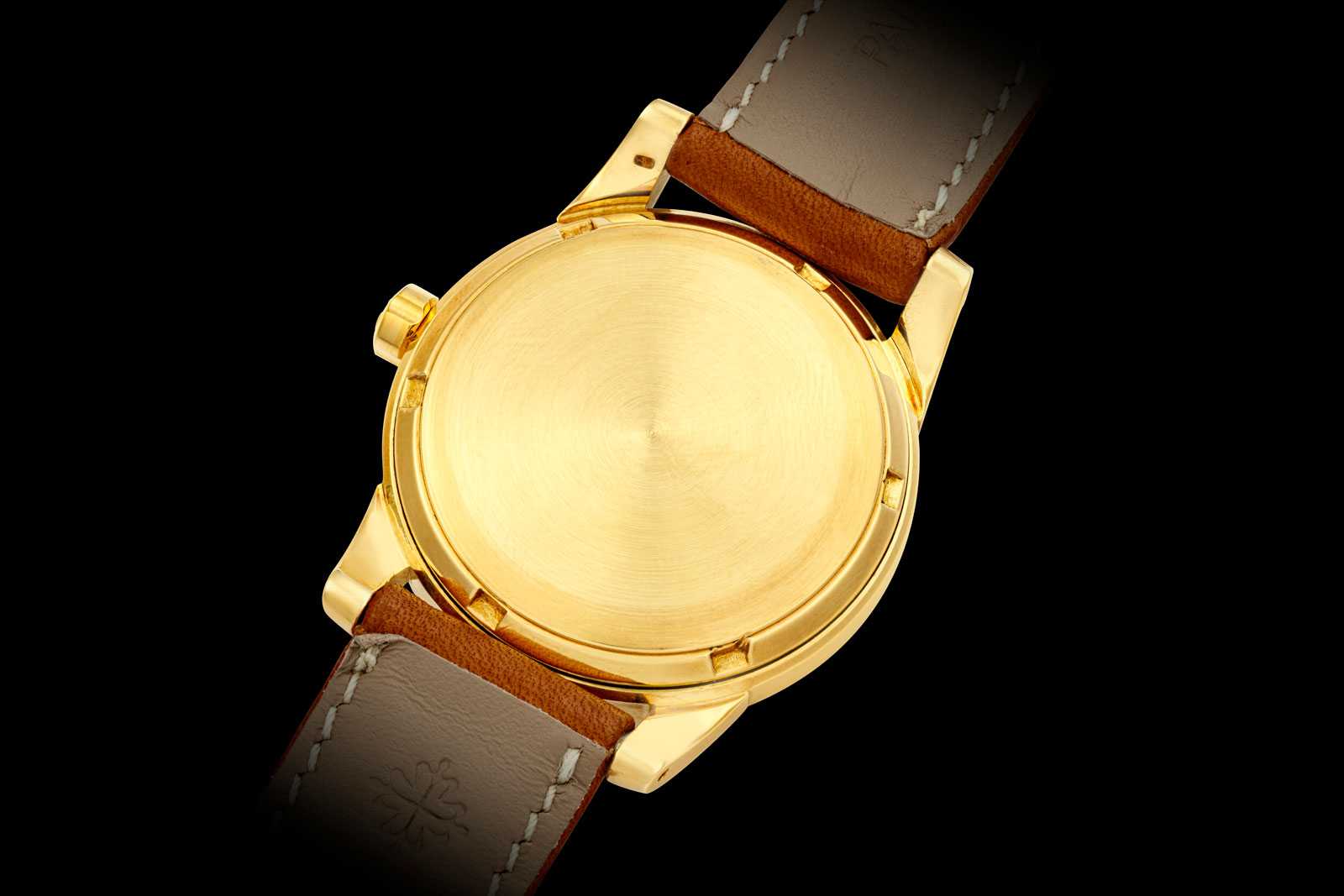
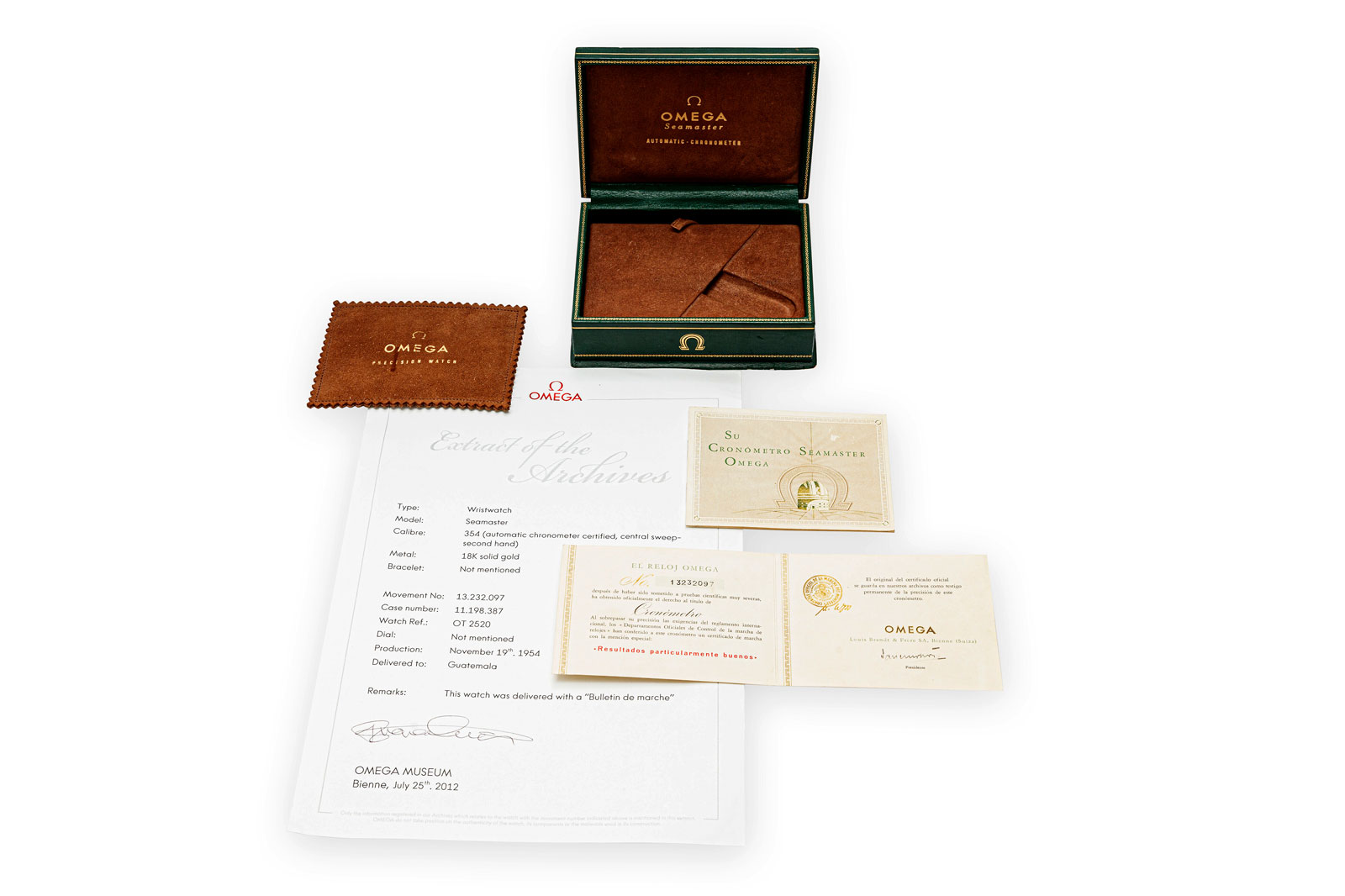
This Omega is accompanied by its original certificate, box, chronometer Bulletin de Marche, and an extract from the archives. It has an estimate of HK$2.0-4.0 million, or about US$256,400-512,800.
To know more, view the listing here.
Preview and auction details
All lots will be on show during the preview in Hong Kong during the run-up to the auction. Both the preview exhibition and sale will happen at the Halls 3C to 3E of the Hong Kong Convention and Exhibition Centre.
Halls 3C-3E, Hong Kong Convention and Exhibition Centre
1 Harbour Road
Wanchai, Hong Kong
Preview
November 25, 10:30 am – 6:30 pm
November 26, 10:30 am – 12:00 pm
Auction
November 26, 1:00 pm (lots 2201-2343)
November 26, 6:30 pm (lots 2501-2639)
All times and dates are local to Hong Kong (GMT+8).
The catalogues for both sessions are online – the first includes the Important Watches sale and the second comprises watches from the OAK Collection.
This was brought to you in collaboration with Christie’s.
Back to top.
